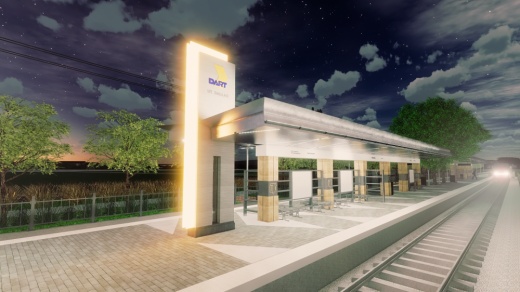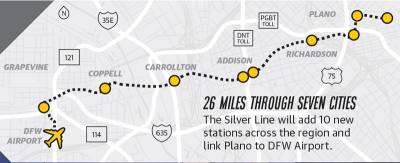The Silver Line is a $1.89 billion commuter rail line being built by DART that will connect Richardson travelers to the Dallas Fort Worth International Airport with an estimated travel time of 51 minutes or less, according to figures released by the transit agency.
DART is funded by a $0.01 sales tax from the 13 Dallas-area cities that make up its service area, including Richardson. The Silver Line is mostly paid for through a $908 million federal loan from the U.S. Department of Transportation and some capital financing programs by DART.
The project was originally planned to be complete this year, but DART announced last summer it would be delayed until late 2024. Complications from the COVID-19 pandemic and issues in acquiring land were cited as factors by DART.
“The biggest concern we had was [COVID-19],” DART spokesperson Gordon Shattles said.
The line follows the route of the old Cotton Belt Railroad freight line. The west end of the 26-mile line will end at DFW Airport Terminal B, and the east end will stop in Plano.
DART will build 10 new stations with two in Richardson.
The CityLine/Bush Station will be located at 1300 E. President George Bush Turnpike and will be connected to the Red Line station there. CityLine is Richardson’s 186-acre mixed-use development, home to a variety of apartments, restaurants, retail centers and corporate campuses.
The other Richardson stop will be The University of Texas at Dallas Station, located at 3416 Waterview Parkway. Both stations should be completed later this year, Shattles said.
Added benefits
With the new stations, a bridge is being built to facilitate the line crossing US 75 just south of the President George Bush Turnpike. Chris Tarango, a DART community engagement representative, said during the agency’s Feb. 9 meeting that the bridge will include an arch design to highlight the corridor as a gateway.
“It is going to be a very nice feature that will really serve as a monument for the city,” Tarango said.
DART officials said construction over the highway should start this summer and will be done at night to avoid affecting traffic.
Richardson Deputy City Manager Don Magner said the new stations will improve mobility for residents while being an important tool for development.
“The connection it provides to DFW Airport will be essential in our economic development strategy,” Magner said. “We continue to try to grow the international business presence here.”
Magner said the transit connection options will make employment areas, such as the city’s Innovation Quarter, a 1,200-acre industrial area south of CityLine, more attractive to potential workers. In a 2018 Richardson vision statement, city officials said they hope The IQ will become the “premier tech hub in Texas.”
Magner said the Silver Line and DART’s Red Line were big selling points for development around CityLine. At the UT Dallas Station, he said, not only will the rail connection benefit students but the land the university owns north and northwest of the station will also become more sought after.
“Much of the undeveloped land in Richardson is around [there],” Magner said. “It has the potential for sustainable property value creation. That is very important.”
Matt Enzler, a senior managing director with Trammell Crow Residential, an apartment development company, said the ability for residents to commute directly to the airport is a strong selling point for those looking to move into Richardson. He said the potential to build “transit-oriented developments” makes those areas more attractive.
“It is a pretty big pain to go from those northern suburbs to [DFW Airport],” Enzler said. “I think it is a pretty big deal that you [will be able to] take a straight shot.
As North Texas began rapidly growing in population, Shattles said DART and regional transportation officials knew the project could create more mobility options in the area.
“We were seeing growth from the center of downtown Dallas past even the farthest suburbs,” he said.
Staying mobile
The North Central Texas Council of Governments, in its official long-term transportation plan, states the need for a “high-performance regional rail network ... throughout North Central Texas.”
The plan recommends spending over $30 billion to expand rail transit systems by 2045. According to the U.S. Census Bureau, Collin County’s population is just over 1 million residents. A 2017 study on the county’s website projects that number to double by 2040.
Dan Lamers, a transportation planning manager with the council, said the board has worked with DART to give commuters more options.
“Driving on congested freeways may not be right for everyone,” he said. “There is no way we can build enough roads.”
Lamers said developing more rail systems using old freight lines—as the Silver Line will—is a cost-effective way to add regional mobility.
“We are looking at all available railroads ... for potential use in the future,” he said.







